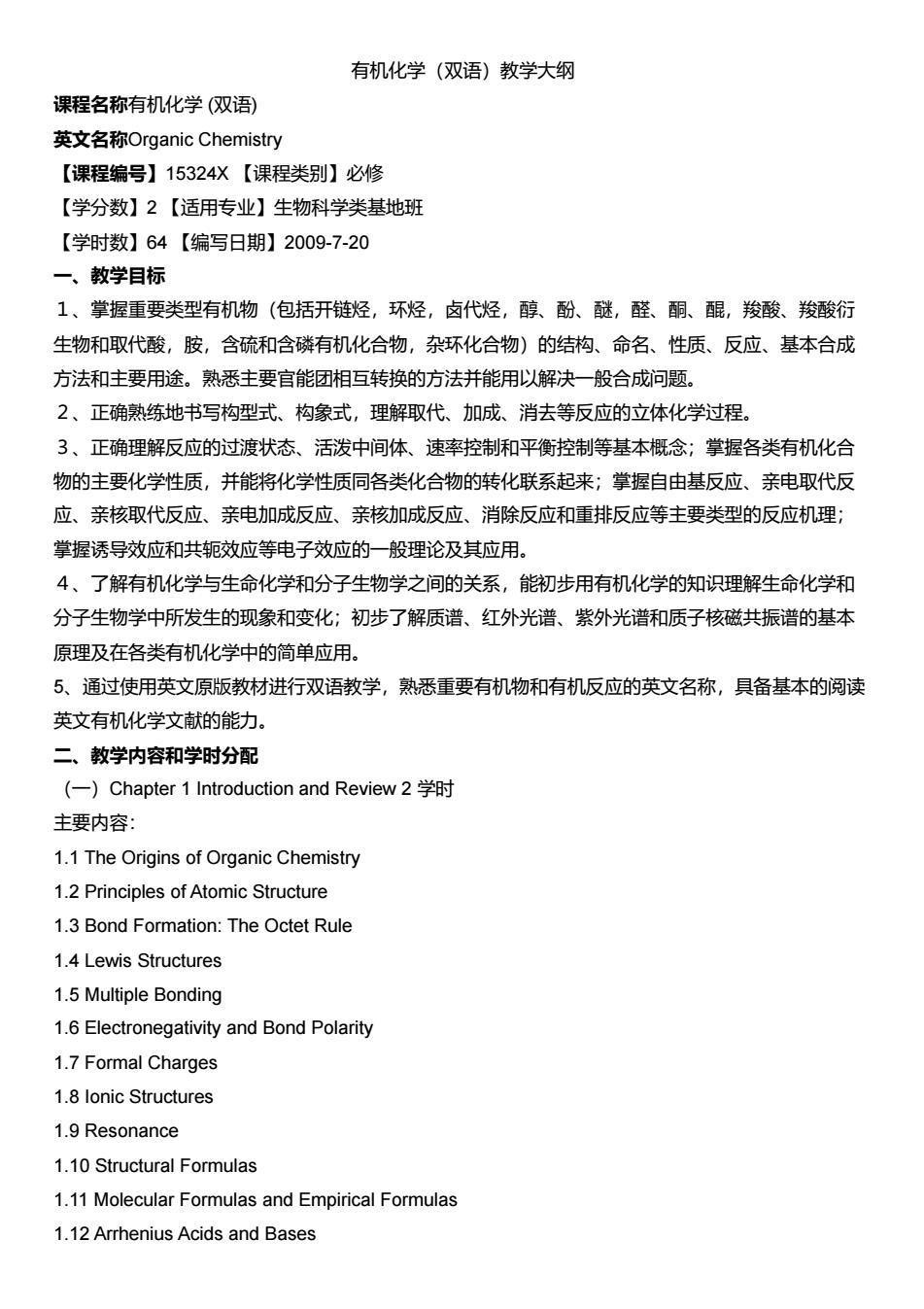
有机化学(双语)教学大纲 课程名称有机化学(双语) 英文名称Organic Chemistry 【课程编号】15324X【课程类别】必修 【学分数】2【适用专业】生物科学类基地班 【学时数】64【编写日期】2009-7-20 一、教学目标 1、掌握重要类型有机物(包括开链烃,环烃,卤代烃,醇、酚、醚,醛、酮、醌,羧酸、羧酸衍 生物和取代酸,胺,含硫和含磷有机化合物,杂环化合物)的结构、命名、性质、反应、基本合成 方法和主要用途。熟悉主要官能团相互转换的方法并能用以解决一般合成问题。 2、正确熟练地书写构型式、构象式,理解取代、加成、消去等反应的立体化学过程。 3、正确理解反应的过渡状态、活泼中间体、速率控制和平衡控制等基本概念;掌握各类有机化合 物的主要化学性质,并能将化学性质同各类化合物的转化联系起来;掌握自由基反应、亲电取代反 应、亲核取代反应、亲电加成反应、亲核加成反应、消除反应和重排反应等主要类型的反应机理; 掌握诱导效应和共轭效应等电子效应的一般理论及其应用。 4、了解有机化学与生命化学和分子生物学之间的关系,能初步用有机化学的知识理解生命化学和 分子生物学中所发生的现象和变化;初步了解质谱、红外光谱、紫外光谱和质子核磁共振谱的基本 原理及在各类有机化学中的简单应用。 5、通过使用英文原版教材进行双语教学,熟悉重要有机物和有机反应的英文名称,具备基本的阅读 英文有机化学文献的能力。 二、教学内容和学时分配 (一)Chapter1 Introduction and Review2学时 主要内容: 1.1 The Origins of Organic Chemistry 1.2 Principles of Atomic Structure 1.3 Bond Formation:The Octet Rule 1.4 Lewis Structures 1.5 Multiple Bonding 1.6 Electronegativity and Bond Polarity 1.7 Formal Charges 1.8 lonic Structures 1.9 Resonance 1.10 Structural Formulas 1.11 Molecular Formulas and Empirical Formulas 1.12 Arrhenius Acids and Bases
有机化学(双语)教学大纲 课程名称有机化学 (双语) 英文名称Organic Chemistry 【课程编号】15324X 【课程类别】必修 【学分数】2 【适用专业】生物科学类基地班 【学时数】64 【编写日期】2009-7-20 一、教学目标 1、掌握重要类型有机物(包括开链烃,环烃,卤代烃,醇、酚、醚,醛、酮、醌,羧酸、羧酸衍 生物和取代酸,胺,含硫和含磷有机化合物,杂环化合物)的结构、命名、性质、反应、基本合成 方法和主要用途。熟悉主要官能团相互转换的方法并能用以解决一般合成问题。 2、正确熟练地书写构型式、构象式,理解取代、加成、消去等反应的立体化学过程。 3、正确理解反应的过渡状态、活泼中间体、速率控制和平衡控制等基本概念;掌握各类有机化合 物的主要化学性质,并能将化学性质同各类化合物的转化联系起来;掌握自由基反应、亲电取代反 应、亲核取代反应、亲电加成反应、亲核加成反应、消除反应和重排反应等主要类型的反应机理; 掌握诱导效应和共轭效应等电子效应的一般理论及其应用。 4、了解有机化学与生命化学和分子生物学之间的关系,能初步用有机化学的知识理解生命化学和 分子生物学中所发生的现象和变化;初步了解质谱、红外光谱、紫外光谱和质子核磁共振谱的基本 原理及在各类有机化学中的简单应用。 5、通过使用英文原版教材进行双语教学,熟悉重要有机物和有机反应的英文名称,具备基本的阅读 英文有机化学文献的能力。 二、教学内容和学时分配 (一)Chapter 1 Introduction and Review 2 学时 主要内容: 1.1 The Origins of Organic Chemistry 1.2 Principles of Atomic Structure 1.3 Bond Formation: The Octet Rule 1.4 Lewis Structures 1.5 Multiple Bonding 1.6 Electronegativity and Bond Polarity 1.7 Formal Charges 1.8 Ionic Structures 1.9 Resonance 1.10 Structural Formulas 1.11 Molecular Formulas and Empirical Formulas 1.12 Arrhenius Acids and Bases
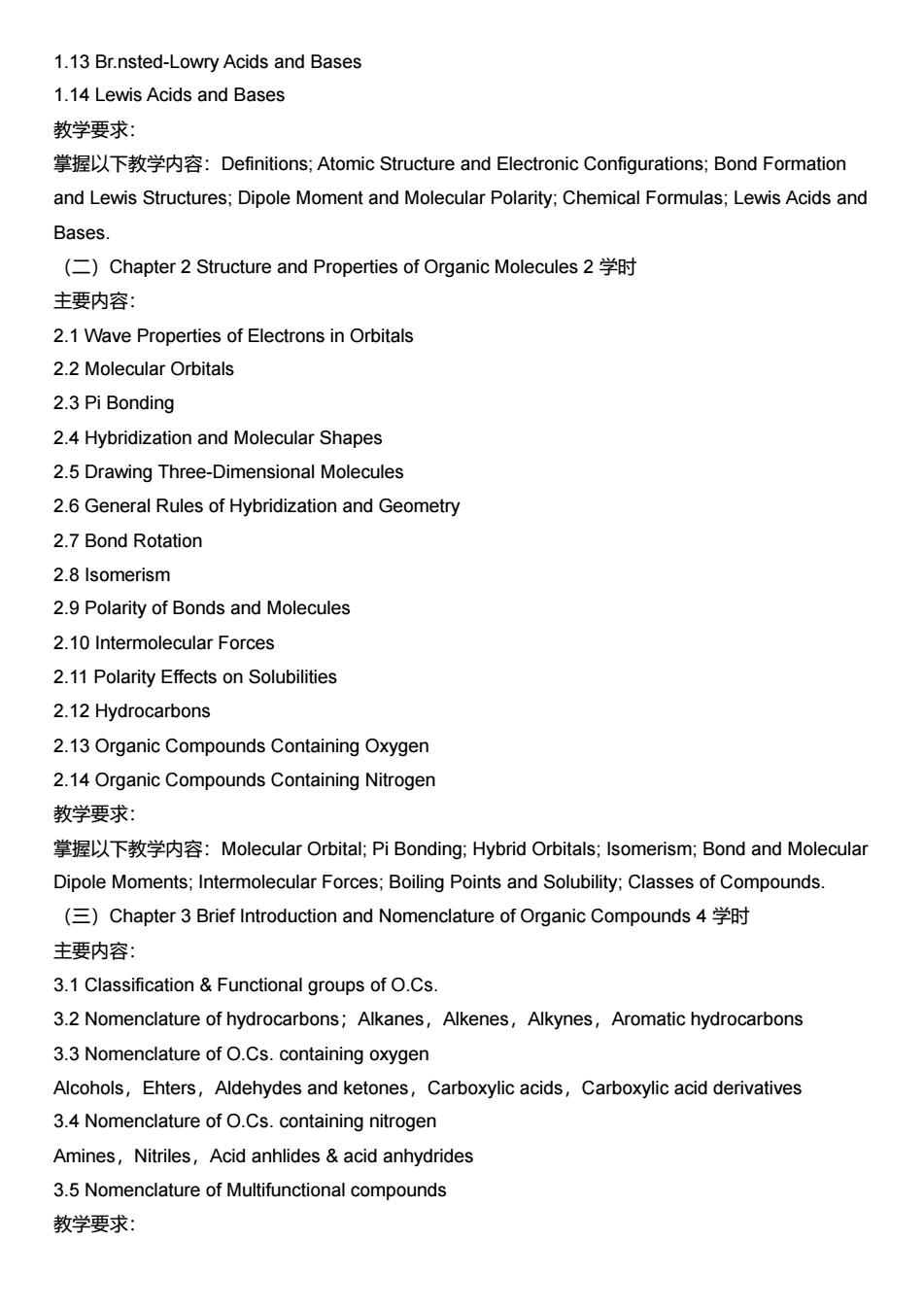
1.13 Br.nsted-Lowry Acids and Bases 1.14 Lewis Acids and Bases 教学要求: 掌握以下教学内容:Definitions;:Atomic Structure and Electronic Configurations;Bond Formation and Lewis Structures:Dipole Moment and Molecular Polarity:Chemical Formulas;Lewis Acids and Bases. (二)Chapter2 Structure and Properties of Organic Molecules2学时 主要内容: 2.1 Wave Properties of Electrons in Orbitals 2.2 Molecular Orbitals 2.3 Pi Bonding 2.4 Hybridization and Molecular Shapes 2.5 Drawing Three-Dimensional Molecules 2.6 General Rules of Hybridization and Geometry 2.7 Bond Rotation 2.8 Isomerism 2.9 Polarity of Bonds and Molecules 2.10 Intermolecular Forces 2.11 Polarity Effects on Solubilities 2.12 Hydrocarbons 2.13 Organic Compounds Containing Oxygen 2.14 Organic Compounds Containing Nitrogen 教学要求: 掌握以下教学内容:Molecular Orbital,Pi Bonding;Hybrid Orbitals;Isomerism;Bond and Molecular Dipole Moments:Intermolecular Forces;Boiling Points and Solubility:Classes of Compounds ()Chapter 3 Brief Introduction and Nomenclature of Organic Compounds4 主要内容: 3.1 Classification Functional groups of O.Cs. 3.2 Nomenclature of hydrocarbons;Alkanes,Alkenes,Alkynes,Aromatic hydrocarbons 3.3 Nomenclature of O.Cs.containing oxygen Alcohols,Ehters,Aldehydes and ketones,Carboxylic acids,Carboxylic acid derivatives 3.4 Nomenclature of O.Cs.containing nitrogen Amines,Nitriles,Acid anhlides &acid anhydrides 3.5 Nomenclature of Multifunctional compounds 教学要求:
1.13 Br.nsted-Lowry Acids and Bases 1.14 Lewis Acids and Bases 教学要求: 掌握以下教学内容:Definitions; Atomic Structure and Electronic Configurations; Bond Formation and Lewis Structures; Dipole Moment and Molecular Polarity; Chemical Formulas; Lewis Acids and Bases. (二)Chapter 2 Structure and Properties of Organic Molecules 2 学时 主要内容: 2.1 Wave Properties of Electrons in Orbitals 2.2 Molecular Orbitals 2.3 Pi Bonding 2.4 Hybridization and Molecular Shapes 2.5 Drawing Three-Dimensional Molecules 2.6 General Rules of Hybridization and Geometry 2.7 Bond Rotation 2.8 Isomerism 2.9 Polarity of Bonds and Molecules 2.10 Intermolecular Forces 2.11 Polarity Effects on Solubilities 2.12 Hydrocarbons 2.13 Organic Compounds Containing Oxygen 2.14 Organic Compounds Containing Nitrogen 教学要求: 掌握以下教学内容:Molecular Orbital; Pi Bonding; Hybrid Orbitals; Isomerism; Bond and Molecular Dipole Moments; Intermolecular Forces; Boiling Points and Solubility; Classes of Compounds. (三)Chapter 3 Brief Introduction and Nomenclature of Organic Compounds 4 学时 主要内容: 3.1 Classification & Functional groups of O.Cs. 3.2 Nomenclature of hydrocarbons;Alkanes,Alkenes,Alkynes,Aromatic hydrocarbons 3.3 Nomenclature of O.Cs. containing oxygen Alcohols,Ehters,Aldehydes and ketones,Carboxylic acids,Carboxylic acid derivatives 3.4 Nomenclature of O.Cs. containing nitrogen Amines,Nitriles,Acid anhlides & acid anhydrides 3.5 Nomenclature of Multifunctional compounds 教学要求:
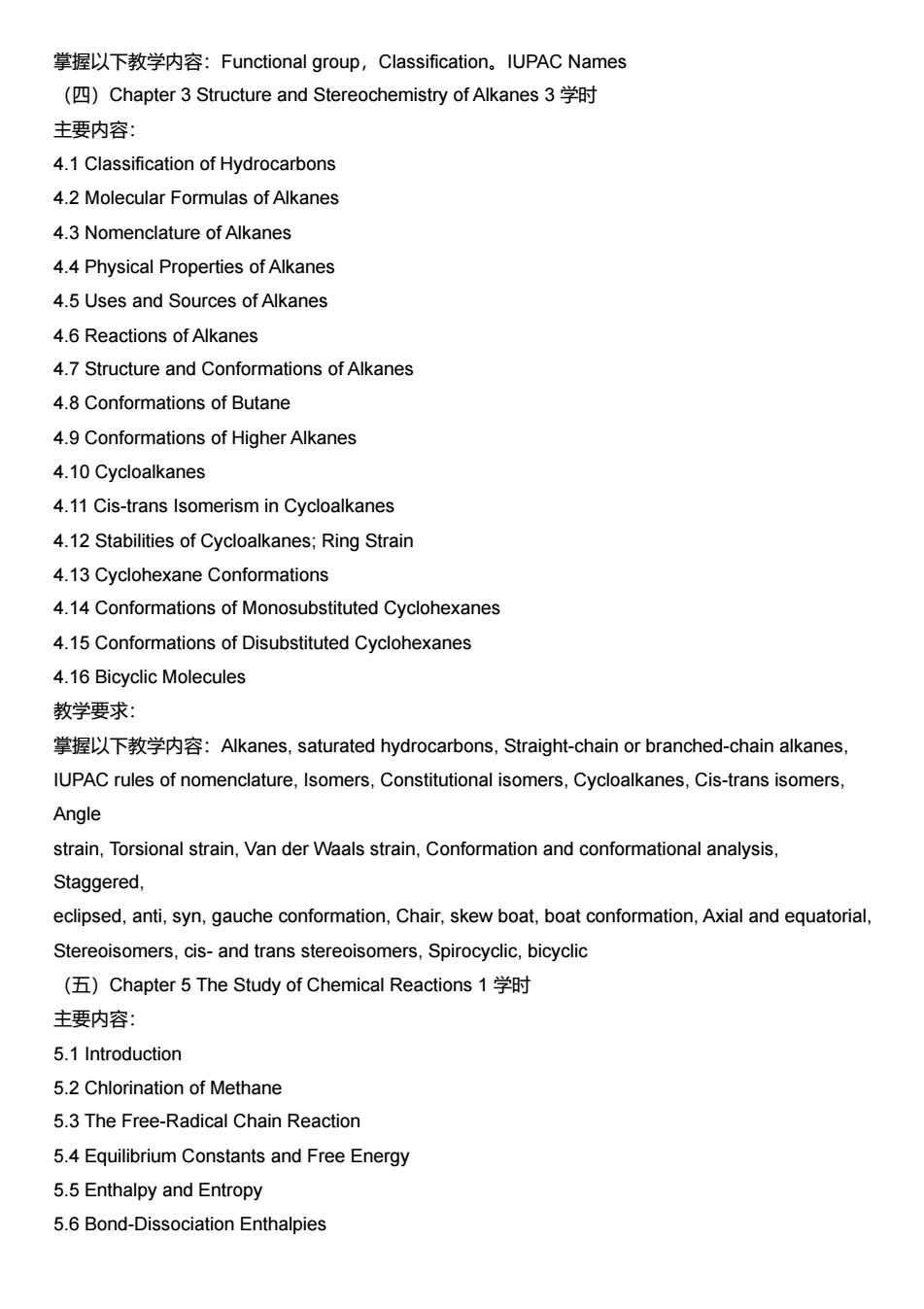
掌握以下教学内容:Functional group,Classification,.UPAC Names (四)Chapter3 Structure and Stereochemistry of Alkanes3学时 主要内容: 4.1 Classification of Hydrocarbons 4.2 Molecular Formulas of Alkanes 4.3 Nomenclature of Alkanes 4.4 Physical Properties of Alkanes 4.5 Uses and Sources of Alkanes 4.6 Reactions of Alkanes 4.7 Structure and Conformations of Alkanes 4.8 Conformations of Butane 4.9 Conformations of Higher Alkanes 4.10 Cycloalkanes 4.11 Cis-trans Isomerism in Cycloalkanes 4.12 Stabilities of Cycloalkanes;Ring Strain 4.13 Cyclohexane Conformations 4.14 Conformations of Monosubstituted Cyclohexanes 4.15 Conformations of Disubstituted Cyclohexanes 4.16 Bicyclic Molecules 教学要求: 掌握以下教学内容:Alkanes,.saturated hydrocarbons,Straight-chain or branched-chain alkanes, IUPAC rules of nomenclature,Isomers,Constitutional isomers,Cycloalkanes,Cis-trans isomers, Angle strain,Torsional strain,Van der Waals strain,Conformation and conformational analysis Staggered, eclipsed,anti,syn,gauche conformation,Chair,skew boat,boat conformation,Axial and equatorial Stereoisomers,cis-and trans stereoisomers.Spirocyclic,bicyclic (伍)Chapter5 The Study of Chemical Reactions1学时 主要内容 5.1 Introduction 5.2 Chlorination of Methane 5.3 The Free-Radical Chain Reaction 5.4 Equilibrium Constants and Free Energy 5.5 Enthalpy and Entropy 5.6 Bond-Dissociation Enthalpies
掌握以下教学内容:Functional group,Classification。IUPAC Names (四)Chapter 3 Structure and Stereochemistry of Alkanes 3 学时 主要内容: 4.1 Classification of Hydrocarbons 4.2 Molecular Formulas of Alkanes 4.3 Nomenclature of Alkanes 4.4 Physical Properties of Alkanes 4.5 Uses and Sources of Alkanes 4.6 Reactions of Alkanes 4.7 Structure and Conformations of Alkanes 4.8 Conformations of Butane 4.9 Conformations of Higher Alkanes 4.10 Cycloalkanes 4.11 Cis-trans Isomerism in Cycloalkanes 4.12 Stabilities of Cycloalkanes; Ring Strain 4.13 Cyclohexane Conformations 4.14 Conformations of Monosubstituted Cyclohexanes 4.15 Conformations of Disubstituted Cyclohexanes 4.16 Bicyclic Molecules 教学要求: 掌握以下教学内容:Alkanes, saturated hydrocarbons, Straight-chain or branched-chain alkanes, IUPAC rules of nomenclature, Isomers, Constitutional isomers, Cycloalkanes, Cis-trans isomers, Angle strain, Torsional strain, Van der Waals strain, Conformation and conformational analysis, Staggered, eclipsed, anti, syn, gauche conformation, Chair, skew boat, boat conformation, Axial and equatorial, Stereoisomers, cis- and trans stereoisomers, Spirocyclic, bicyclic (五)Chapter 5 The Study of Chemical Reactions 1 学时 主要内容: 5.1 Introduction 5.2 Chlorination of Methane 5.3 The Free-Radical Chain Reaction 5.4 Equilibrium Constants and Free Energy 5.5 Enthalpy and Entropy 5.6 Bond-Dissociation Enthalpies

5.7 Enthalpy Changes in Chlorination 5.8 Kinetics and the Rate Equation 5.9 Activation Energy and the Temperature Dependence of Rates 5.10 Transition States 5.11 Rates of Multistep Reactions 5.12 Temperature Dependence of Halogenation 5.13 Selectivity in Halogenation 5.14 The Hammond Postulate 5.15 Radical Inhibitors 5.16 Reactive Intermediates 教学要求: 掌握以下教学内容:Reactions:Addition,.Elimination,Substitution,Rearrangement;Mechanisms Radical,Polar,Nucleophile and electrophile,Transition states and intermediates (六)Chapter6 Stereochemistry4学时 主要内容: 6.1 Introduction 6.2 Chirality 6.3(R)and(S)Nomenclature of Asymmetric Carbon Atoms 6.4 Optical Activity 6.5 Biological Discrimination of Enantiomers 6.6 Racemic Mixtures 6.7 Enantiomeric Excess and Optical Purity 6.8 Chirality of Conformationally Mobile Systems 6.9 Chiral Compounds without Asymmetric Atoms 6.10 Fischer Projections 6.11 Diastereomers 6.12 Stereochemistry of Molecules with Two or More Asymmetric Carbons 6.13 Meso Compounds 6.14Absolute and Relative Configuration 6.15 Physical Properties of Diastereomers 6.16 Resolution of Enantiomers 教学要求: 掌握以下教学内容:Stereochemistry,Chiral enantiomers,Chirality center,,Optical activity,.Optical rotations,Racemic mixture configuration,R and S of the Cahn-Ingold-Prelog notational system
5.7 Enthalpy Changes in Chlorination 5.8 Kinetics and the Rate Equation 5.9 Activation Energy and the Temperature Dependence of Rates 5.10 Transition States 5.11 Rates of Multistep Reactions 5.12 Temperature Dependence of Halogenation 5.13 Selectivity in Halogenation 5.14 The Hammond Postulate 5.15 Radical Inhibitors 5.16 Reactive Intermediates 教学要求: 掌握以下教学内容:Reactions: Addition, Elimination, Substitution, Rearrangement; Mechanisms: Radical,Polar, Nucleophile and electrophile, Transition states and intermediates (六)Chapter 6 Stereochemistry 4 学时 主要内容: 6.1 Introduction 6.2 Chirality 6.3 (R) and (S) Nomenclature of Asymmetric Carbon Atoms 6.4 Optical Activity 6.5 Biological Discrimination of Enantiomers 6.6 Racemic Mixtures 6.7 Enantiomeric Excess and Optical Purity 6.8 Chirality of Conformationally Mobile Systems 6.9 Chiral Compounds without Asymmetric Atoms 6.10 Fischer Projections 6.11 Diastereomers 6.12 Stereochemistry of Molecules with Two or More Asymmetric Carbons 6.13 Meso Compounds 6.14 Absolute and Relative Configuration 6.15 Physical Properties of Diastereomers 6.16 Resolution of Enantiomers 教学要求: 掌握以下教学内容:Stereochemistry, Chiral enantiomers, Chirality center, Optical activity, Optical rotations, Racemic mixture configuration, R and S of the Cahn–Ingold–Prelog notational system
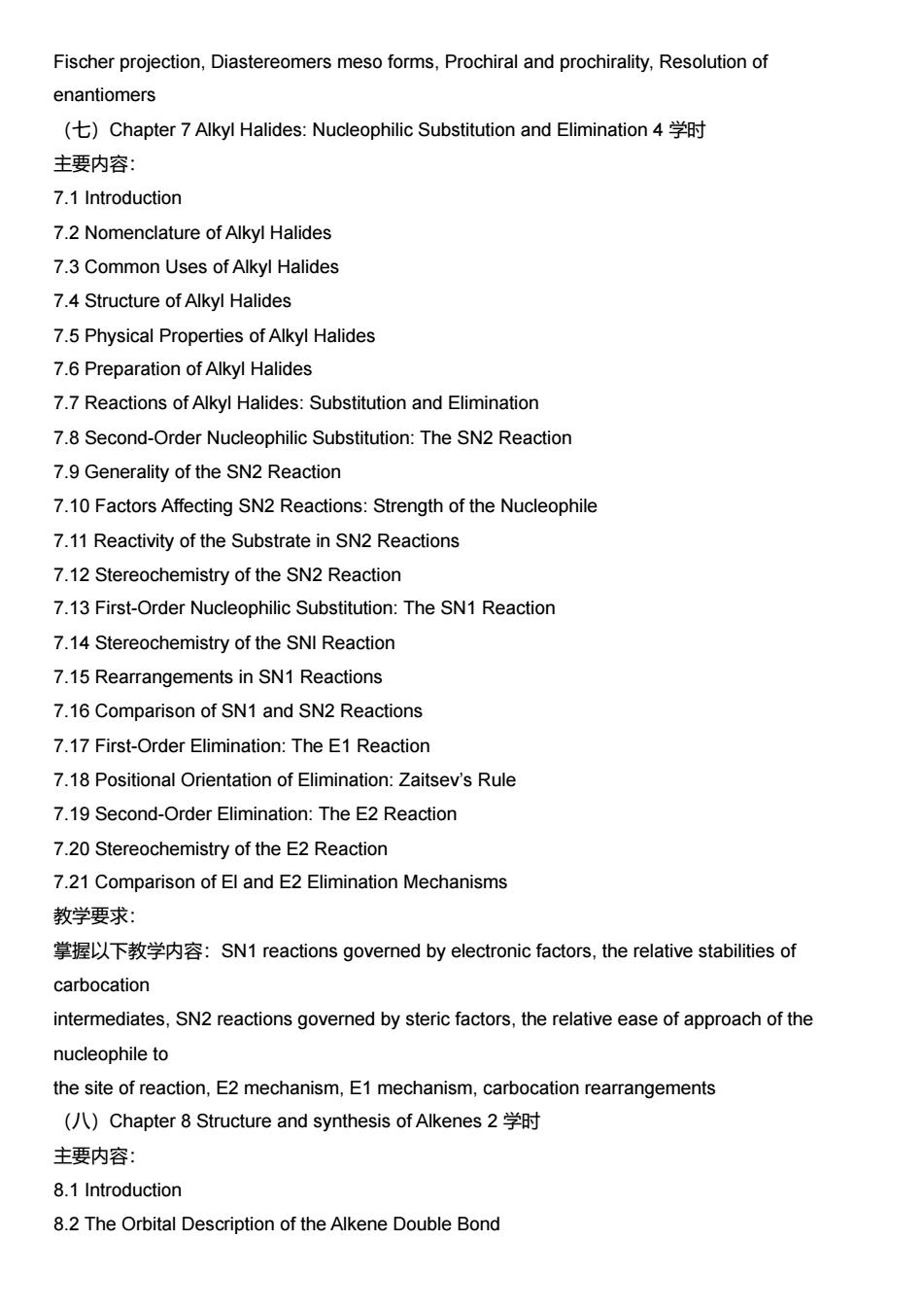
Fischer projection,Diastereomers meso forms,Prochiral and prochirality,Resolution of enantiomers ()Chapter 7 Alkyl Halides:Nucleophilic Substitution and Elimination 4 主要内容: 7.1 Introduction 7.2 Nomenclature of Alkyl Halides 7.3 Common Uses of Alkyl Halides 7.4 Structure of Alkyl Halides 7.5 Physical Properties of Alkyl Halides 7.6 Preparation of Alkyl Halides 7.7 Reactions of Alkyl Halides:Substitution and Elimination 7.8 Second-Order Nucleophilic Substitution:The SN2 Reaction 7.9 Generality of the SN2 Reaction 7.10 Factors Affecting SN2 Reactions:Strength of the Nucleophile 7.11 Reactivity of the Substrate in SN2 Reactions 7.12 Stereochemistry of the SN2 Reaction 7.13 First-Order Nucleophilic Substitution:The SN1 Reaction 7.14 Stereochemistry of the SNI Reaction 7.15 Rearrangements in SN1 Reactions 7.16 Comparison of SN1 and SN2 Reactions 7.17 First-Order Elimination:The E1 Reaction 7.18 Positional Orientation of Elimination:Zaitsev's Rule 7.19 Second-Order Elimination:The E2 Reaction 7.20 Stereochemistry of the E2 Reaction 7.21 Comparison of El and E2 Elimination Mechanisms 教学要求: 掌握以下教学内容:SN1 reactions governed by electronic factors,.the relative stabilities of carbocation intermediates,SN2 reactions governed by steric factors,the relative ease of approach of the nucleophile to the site of reaction,E2 mechanism,E1 mechanism,carbocation rearrangements (八)Chapter8 Structure and synthesis of Alkenes2学时 主要内容: 8.1 Introduction 8.2 The Orbital Description of the Alkene Double Bond
Fischer projection, Diastereomers meso forms, Prochiral and prochirality, Resolution of enantiomers (七)Chapter 7 Alkyl Halides: Nucleophilic Substitution and Elimination 4 学时 主要内容: 7.1 Introduction 7.2 Nomenclature of Alkyl Halides 7.3 Common Uses of Alkyl Halides 7.4 Structure of Alkyl Halides 7.5 Physical Properties of Alkyl Halides 7.6 Preparation of Alkyl Halides 7.7 Reactions of Alkyl Halides: Substitution and Elimination 7.8 Second-Order Nucleophilic Substitution: The SN2 Reaction 7.9 Generality of the SN2 Reaction 7.10 Factors Affecting SN2 Reactions: Strength of the Nucleophile 7.11 Reactivity of the Substrate in SN2 Reactions 7.12 Stereochemistry of the SN2 Reaction 7.13 First-Order Nucleophilic Substitution: The SN1 Reaction 7.14 Stereochemistry of the SNl Reaction 7.15 Rearrangements in SN1 Reactions 7.16 Comparison of SN1 and SN2 Reactions 7.17 First-Order Elimination: The E1 Reaction 7.18 Positional Orientation of Elimination: Zaitsev’s Rule 7.19 Second-Order Elimination: The E2 Reaction 7.20 Stereochemistry of the E2 Reaction 7.21 Comparison of El and E2 Elimination Mechanisms 教学要求: 掌握以下教学内容:SN1 reactions governed by electronic factors, the relative stabilities of carbocation intermediates, SN2 reactions governed by steric factors, the relative ease of approach of the nucleophile to the site of reaction, E2 mechanism, E1 mechanism, carbocation rearrangements (八)Chapter 8 Structure and synthesis of Alkenes 2 学时 主要内容: 8.1 Introduction 8.2 The Orbital Description of the Alkene Double Bond
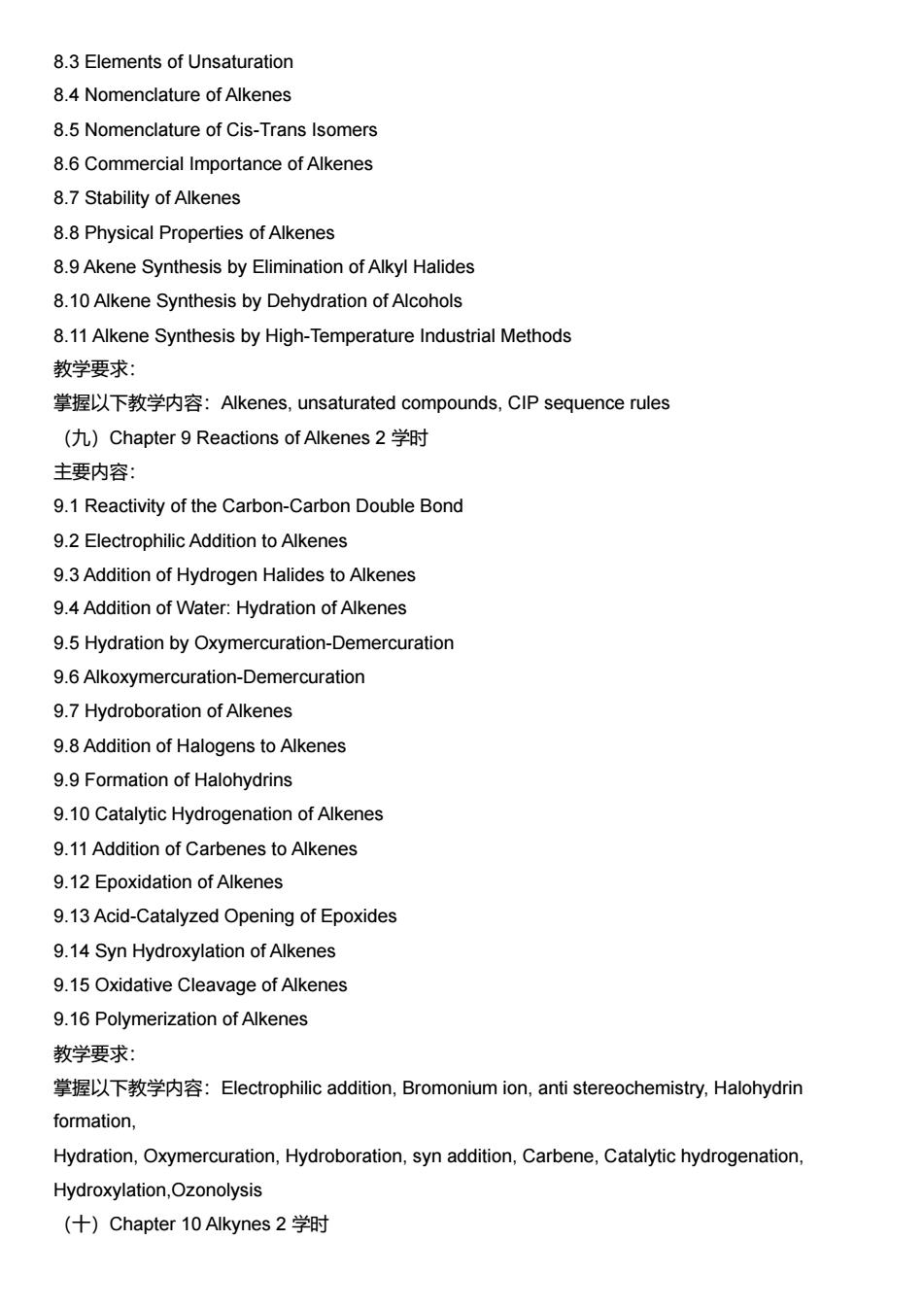
8.3 Elements of Unsaturation 8.4 Nomenclature of Alkenes 8.5 Nomenclature of Cis-Trans Isomers 8.6 Commercial Importance of Alkenes 8.7 Stability of Alkenes 8.8 Physical Properties of Alkenes 8.9 Akene Synthesis by Elimination of Alkyl Halides 8.10 Alkene Synthesis by Dehydration of Alcohols 8.11 Alkene Synthesis by High-Temperature Industrial Methods 教学要求: 掌握以下教学内容:Alkenes,unsaturated compounds,.CIP sequence rules (九)Chapter9 Reactions of Alkenes2学时 主要内容: 9.1 Reactivity of the Carbon-Carbon Double Bond 9.2 Electrophilic Addition to Alkenes 9.3 Addition of Hydrogen Halides to Alkenes 9.4 Addition of Water:Hydration of Alkenes 9.5 Hydration by Oxymercuration-Demercuration 9.6 Alkoxymercuration-Demercuration 9.7 Hydroboration of Alkenes 9.8 Addition of Halogens to Alkenes 9.9 Formation of Halohydrins 9.10 Catalytic Hydrogenation of Alkenes 9.11 Addition of Carbenes to Alkenes 9.12 Epoxidation of Alkenes 9.13 Acid-Catalyzed Opening of Epoxides 9.14 Syn Hydroxylation of Alkenes 9.15 Oxidative Cleavage of Alkenes 9.16 Polymerization of Alkenes 教学要求: 掌握以下教学内容:Electrophilic addition,Bromonium ion,anti stereochemistry,Halohydrin formation, Hydration,Oxymercuration,Hydroboration,syn addition,Carbene,Catalytic hydrogenation, Hydroxylation,Ozonolysis (十)Chapter10 Alkynes2学时
8.3 Elements of Unsaturation 8.4 Nomenclature of Alkenes 8.5 Nomenclature of Cis-Trans Isomers 8.6 Commercial Importance of Alkenes 8.7 Stability of Alkenes 8.8 Physical Properties of Alkenes 8.9 Akene Synthesis by Elimination of Alkyl Halides 8.10 Alkene Synthesis by Dehydration of Alcohols 8.11 Alkene Synthesis by High-Temperature Industrial Methods 教学要求: 掌握以下教学内容:Alkenes, unsaturated compounds, CIP sequence rules (九)Chapter 9 Reactions of Alkenes 2 学时 主要内容: 9.1 Reactivity of the Carbon-Carbon Double Bond 9.2 Electrophilic Addition to Alkenes 9.3 Addition of Hydrogen Halides to Alkenes 9.4 Addition of Water: Hydration of Alkenes 9.5 Hydration by Oxymercuration-Demercuration 9.6 Alkoxymercuration-Demercuration 9.7 Hydroboration of Alkenes 9.8 Addition of Halogens to Alkenes 9.9 Formation of Halohydrins 9.10 Catalytic Hydrogenation of Alkenes 9.11 Addition of Carbenes to Alkenes 9.12 Epoxidation of Alkenes 9.13 Acid-Catalyzed Opening of Epoxides 9.14 Syn Hydroxylation of Alkenes 9.15 Oxidative Cleavage of Alkenes 9.16 Polymerization of Alkenes 教学要求: 掌握以下教学内容:Electrophilic addition, Bromonium ion, anti stereochemistry, Halohydrin formation, Hydration, Oxymercuration, Hydroboration, syn addition, Carbene, Catalytic hydrogenation, Hydroxylation,Ozonolysis (十)Chapter 10 Alkynes 2 学时
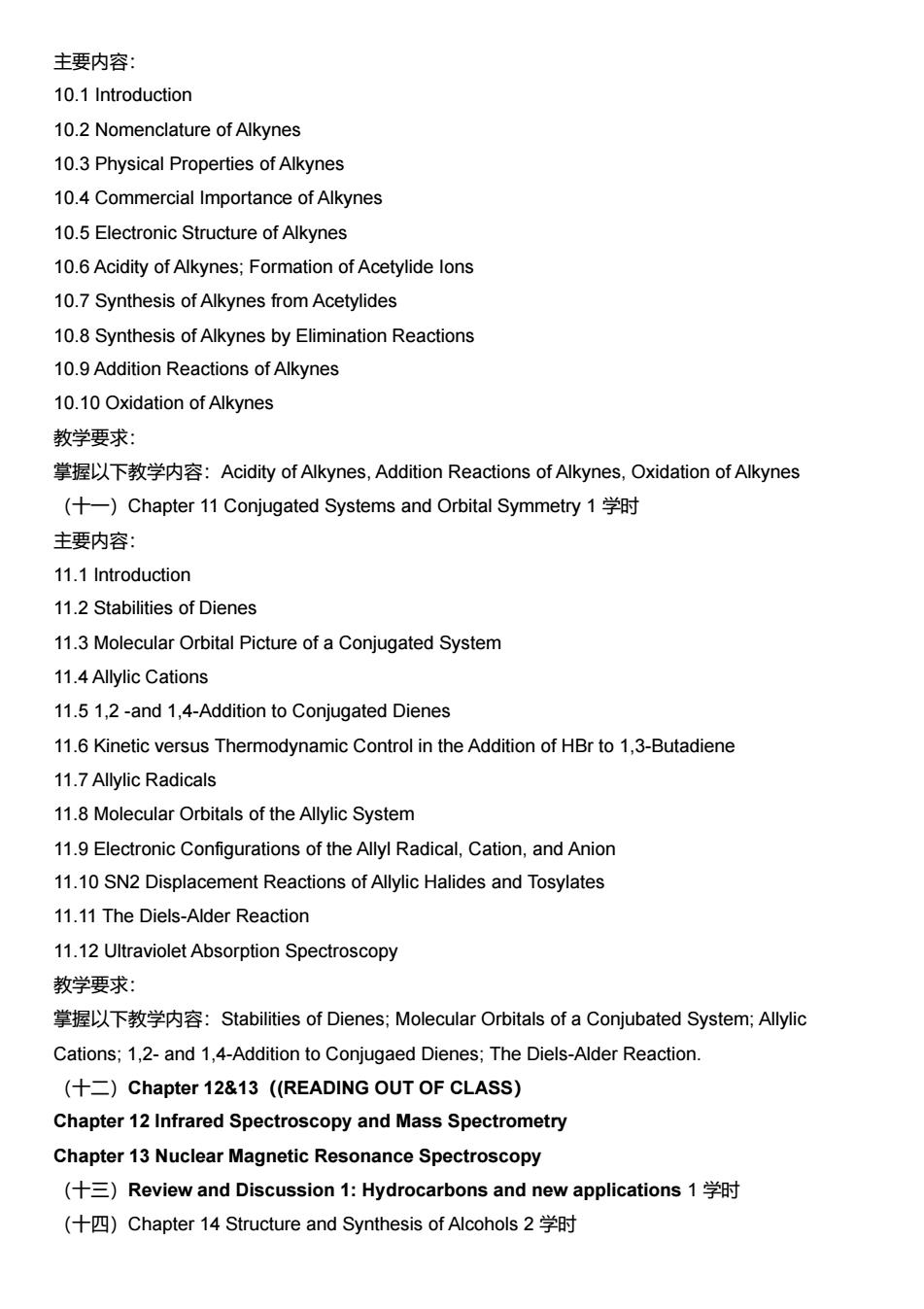
主要内容 10.1 Introduction 10.2 Nomenclature of Alkynes 10.3 Physical Properties of Alkynes 10.4 Commercial Importance of Alkynes 10.5 Electronic Structure of Alkynes 10.6 Acidity of Alkynes;Formation of Acetylide lons 10.7 Synthesis of Alkynes from Acetylides 10.8 Synthesis of Alkynes by Elimination Reactions 10.9 Addition Reactions of Alkynes 10.10 Oxidation of Alkynes 教学要求: 掌握以下教学内容:Acidity of Alkynes,Addition Reactions of Alkynes,.Oxidation of Alkynes (什-)Chapter11 Conjugated Systems and Orbital Symmetry1学时 主要内容 11.1 Introduction 11.2 Stabilities of Dienes 11.3 Molecular Orbital Picture of a Conjugated System 11.4 Allylic Cations 11.5 1,2-and 1,4-Addition to Conjugated Dienes 11.6 Kinetic versus Thermodynamic Control in the Addition of HBr to 1,3-Butadiene 11.7 Allylic Radicals 11.8 Molecular Orbitals of the Allylic System 11.9 Electronic Configurations of the Allyl Radical,Cation,and Anion 11.10 SN2 Displacement Reactions of Allylic Halides and Tosylates 11.11 The Diels-Alder Reaction 11.12 Ultraviolet Absorption Spectroscopy 教学要求: 掌握以下教学内容:Stabilities of Dienes;:Molecular Orbitals of a Conjubated System;Allylic Cations;1.2-and 1.4-Addition to Conjugaed Dienes;The Diels-Alder Reaction. (+)Chapter 12&13 ((READING OUT OF CLASS) Chapter 12 Infrared Spectroscopy and Mass Spectrometry Chapter 13 Nuclear Magnetic Resonance Spectroscopy (十三)Review and Discussion1:Hydrocarbons and new applications1学时 (十四)Chapter14 Structure and Synthesis of Alcohols2学时
主要内容: 10.1 Introduction 10.2 Nomenclature of Alkynes 10.3 Physical Properties of Alkynes 10.4 Commercial Importance of Alkynes 10.5 Electronic Structure of Alkynes 10.6 Acidity of Alkynes; Formation of Acetylide Ions 10.7 Synthesis of Alkynes from Acetylides 10.8 Synthesis of Alkynes by Elimination Reactions 10.9 Addition Reactions of Alkynes 10.10 Oxidation of Alkynes 教学要求: 掌握以下教学内容:Acidity of Alkynes, Addition Reactions of Alkynes, Oxidation of Alkynes (十一)Chapter 11 Conjugated Systems and Orbital Symmetry 1 学时 主要内容: 11.1 Introduction 11.2 Stabilities of Dienes 11.3 Molecular Orbital Picture of a Conjugated System 11.4 Allylic Cations 11.5 1,2 -and 1,4-Addition to Conjugated Dienes 11.6 Kinetic versus Thermodynamic Control in the Addition of HBr to 1,3-Butadiene 11.7 Allylic Radicals 11.8 Molecular Orbitals of the Allylic System 11.9 Electronic Configurations of the Allyl Radical, Cation, and Anion 11.10 SN2 Displacement Reactions of Allylic Halides and Tosylates 11.11 The Diels-Alder Reaction 11.12 Ultraviolet Absorption Spectroscopy 教学要求: 掌握以下教学内容:Stabilities of Dienes; Molecular Orbitals of a Conjubated System; Allylic Cations; 1,2- and 1,4-Addition to Conjugaed Dienes; The Diels-Alder Reaction. (十二)Chapter 12&13((READING OUT OF CLASS) Chapter 12 Infrared Spectroscopy and Mass Spectrometry Chapter 13 Nuclear Magnetic Resonance Spectroscopy (十三)Review and Discussion 1: Hydrocarbons and new applications 1 学时 (十四)Chapter 14 Structure and Synthesis of Alcohols 2 学时
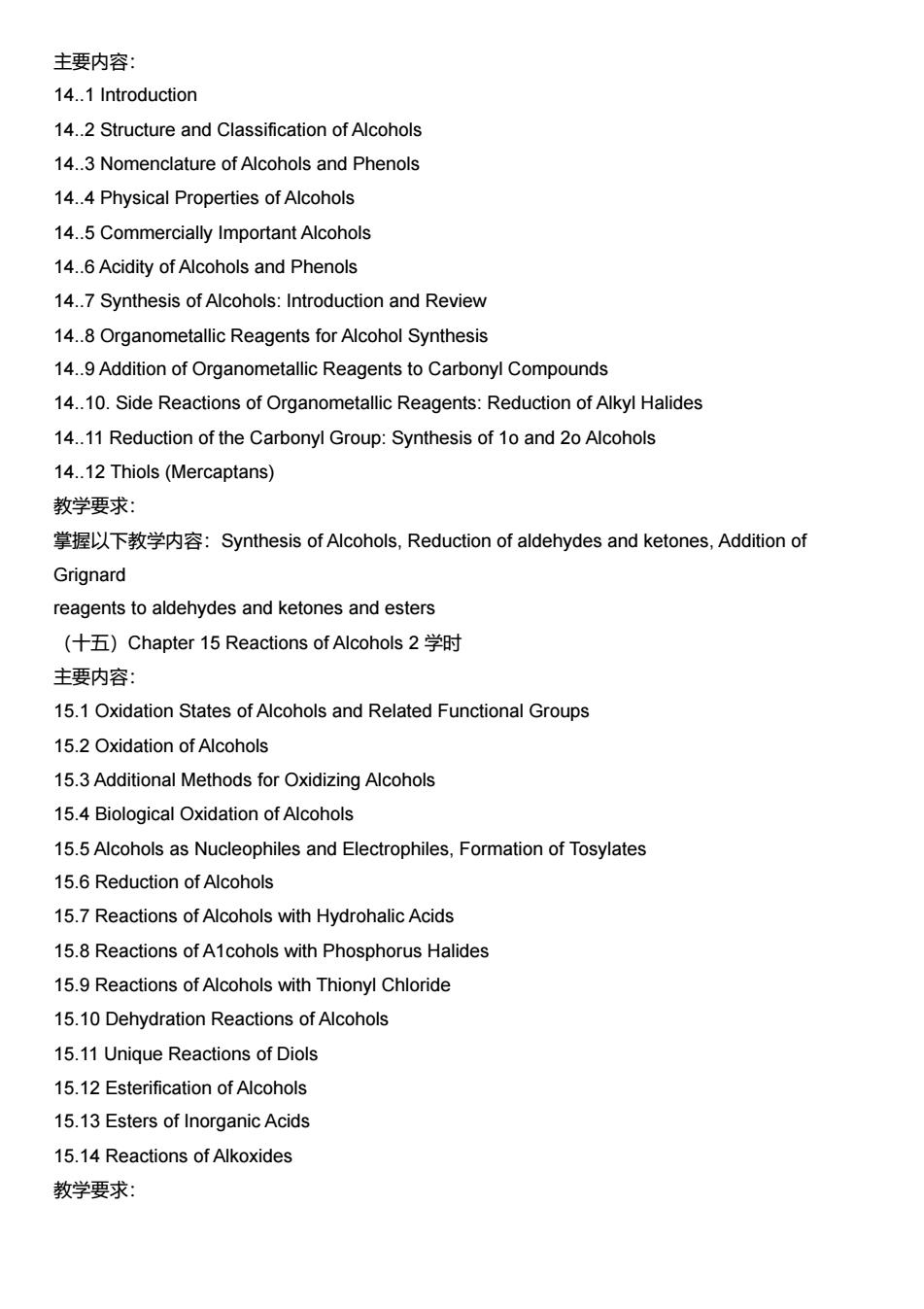
主要内容: 14..1 Introduction 14..2 Structure and Classification of Alcohols 14..3 Nomenclature of Alcohols and Phenols 14..4 Physical Properties of Alcohols 14..5 Commercially Important Alcohols 14..6 Acidity of Alcohols and Phenols 14..7 Synthesis of Alcohols:Introduction and Review 14..8 Organometallic Reagents for Alcohol Synthesis 14..9 Addition of Organometallic Reagents to Carbonyl Compounds 14..10.Side Reactions of Organometallic Reagents:Reduction of Alkyl Halides 14.11 Reduction of the Carbonyl Group:Synthesis of 1o and 2o Alcohols 14..12 Thiols(Mercaptans) 教学要求: 掌握以下教学内容:Synthesis of Alcohols,.Reduction of aldehydes and ketones,Addition of Grignard reagents to aldehydes and ketones and esters (十五)Chapter15 Reactions of Alcohols2学时 主要内容: 15.1 Oxidation States of Alcohols and Related Functional Groups 15.2 Oxidation of Alcohols 15.3 Additional Methods for Oxidizing Alcohols 15.4 Biological Oxidation of Alcohols 15.5 Alcohols as Nucleophiles and Electrophiles,Formation of Tosylates 15.6 Reduction of Alcohols 15.7 Reactions of Alcohols with Hydrohalic Acids 15.8 Reactions of A1cohols with Phosphorus Halides 15.9 Reactions of Alcohols with Thionyl Chloride 15.10 Dehydration Reactions of Alcohols 15.11 Unique Reactions of Diols 15.12 Esterification of Alcohols 15.13 Esters of Inorganic Acids 15.14 Reactions of Alkoxides 教学要求:
主要内容: 14..1 Introduction 14..2 Structure and Classification of Alcohols 14..3 Nomenclature of Alcohols and Phenols 14..4 Physical Properties of Alcohols 14..5 Commercially Important Alcohols 14..6 Acidity of Alcohols and Phenols 14..7 Synthesis of Alcohols: Introduction and Review 14..8 Organometallic Reagents for Alcohol Synthesis 14..9 Addition of Organometallic Reagents to Carbonyl Compounds 14..10. Side Reactions of Organometallic Reagents: Reduction of Alkyl Halides 14..11 Reduction of the Carbonyl Group: Synthesis of 1o and 2o Alcohols 14..12 Thiols (Mercaptans) 教学要求: 掌握以下教学内容:Synthesis of Alcohols, Reduction of aldehydes and ketones, Addition of Grignard reagents to aldehydes and ketones and esters (十五)Chapter 15 Reactions of Alcohols 2 学时 主要内容: 15.1 Oxidation States of Alcohols and Related Functional Groups 15.2 Oxidation of Alcohols 15.3 Additional Methods for Oxidizing Alcohols 15.4 Biological Oxidation of Alcohols 15.5 Alcohols as Nucleophiles and Electrophiles, Formation of Tosylates 15.6 Reduction of Alcohols 15.7 Reactions of Alcohols with Hydrohalic Acids 15.8 Reactions of A1cohols with Phosphorus Halides 15.9 Reactions of Alcohols with Thionyl Chloride 15.10 Dehydration Reactions of Alcohols 15.11 Unique Reactions of Diols 15.12 Esterification of Alcohols 15.13 Esters of Inorganic Acids 15.14 Reactions of Alkoxides 教学要求:
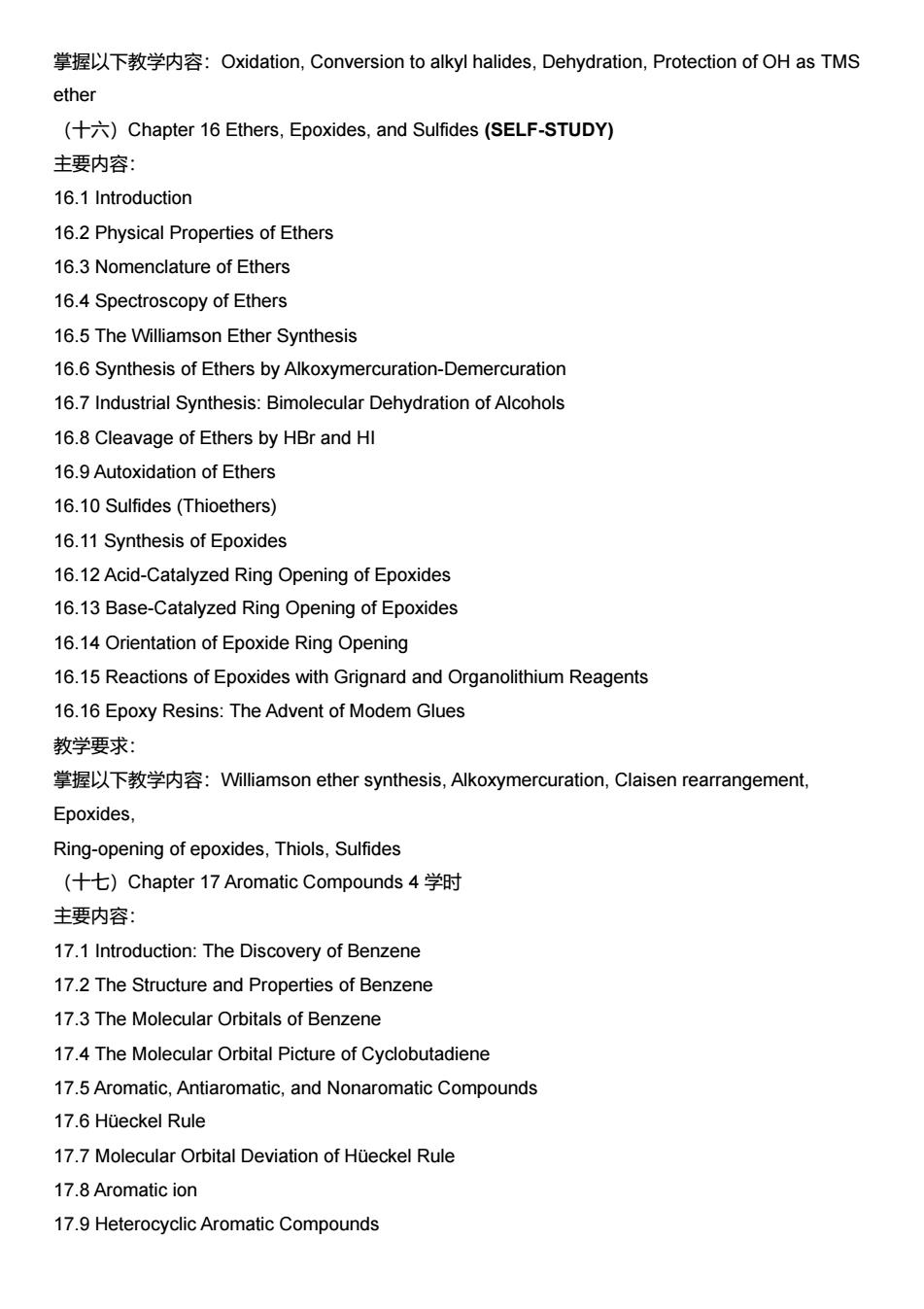
掌握以下教学内容:Oxidation,.Conversion to alkyl halides,Dehydration,Protection of OH as TMS ether ()Chapter 16 Ethers,Epoxides,and Sulfides(SELF-STUDY) 主要内容 16.1 Introduction 16.2 Physical Properties of Ethers 16.3 Nomenclature of Ethers 16.4 Spectroscopy of Ethers 16.5 The Williamson Ether Synthesis 16.6 Synthesis of Ethers by Alkoxymercuration-Demercuration 16.7 Industrial Synthesis:Bimolecular Dehydration of Alcohols 16.8 Cleavage of Ethers by HBr and HI 16.9 Autoxidation of Ethers 16.10 Sulfides(Thioethers) 16.11 Synthesis of Epoxides 16.12 Acid-Catalyzed Ring Opening of Epoxides 16.13 Base-Catalyzed Ring Opening of Epoxides 16.14 Orientation of Epoxide Ring Opening 16.15 Reactions of Epoxides with Grignard and Organolithium Reagents 16.16 Epoxy Resins:The Advent of Modem Glues 教学要求: 掌握以下教学内容:Villiamson ether synthesis,Alkoxymercuration,Claisen rearrangement, Epoxides. Ring-opening of epoxides,Thiols,Sulfides (十七)Chapter17 Aromatic Compounds4学时 主要内容: 17.1 Introduction:The Discovery of Benzene 17.2 The Structure and Properties of Benzene 17.3 The Molecular Orbitals of Benzene 17.4 The Molecular Orbital Picture of Cyclobutadiene 17.5 Aromatic,Antiaromatic,and Nonaromatic Compounds 17.6 Hueckel Rule 17.7 Molecular Orbital Deviation of Hueckel Rule 17.8 Aromatic ion 17.9 Heterocyclic Aromatic Compounds
掌握以下教学内容:Oxidation, Conversion to alkyl halides, Dehydration, Protection of OH as TMS ether (十六)Chapter 16 Ethers, Epoxides, and Sulfides (SELF-STUDY) 主要内容: 16.1 Introduction 16.2 Physical Properties of Ethers 16.3 Nomenclature of Ethers 16.4 Spectroscopy of Ethers 16.5 The Williamson Ether Synthesis 16.6 Synthesis of Ethers by Alkoxymercuration-Demercuration 16.7 Industrial Synthesis: Bimolecular Dehydration of Alcohols 16.8 Cleavage of Ethers by HBr and HI 16.9 Autoxidation of Ethers 16.10 Sulfides (Thioethers) 16.11 Synthesis of Epoxides 16.12 Acid-Catalyzed Ring Opening of Epoxides 16.13 Base-Catalyzed Ring Opening of Epoxides 16.14 Orientation of Epoxide Ring Opening 16.15 Reactions of Epoxides with Grignard and Organolithium Reagents 16.16 Epoxy Resins: The Advent of Modem Glues 教学要求: 掌握以下教学内容:Williamson ether synthesis, Alkoxymercuration, Claisen rearrangement, Epoxides, Ring-opening of epoxides, Thiols, Sulfides (十七)Chapter 17 Aromatic Compounds 4 学时 主要内容: 17.1 Introduction: The Discovery of Benzene 17.2 The Structure and Properties of Benzene 17.3 The Molecular Orbitals of Benzene 17.4 The Molecular Orbital Picture of Cyclobutadiene 17.5 Aromatic, Antiaromatic, and Nonaromatic Compounds 17.6 Hüeckel Rule 17.7 Molecular Orbital Deviation of Hüeckel Rule 17.8 Aromatic ion 17.9 Heterocyclic Aromatic Compounds

17.10 Polynuclear Aromatic Hydrocarbons 17.11 Aromatic Allotropes of carbon 17.12 Fused Heterocyclic Compounds 17.13 Nomenclature of Benzene Derivatives 17.14 Physical Properties of Benzene and Its Derivatives 17.15 Spectroscopy of Aromatic Compounds 教学要求: 掌握以下教学内容:The Structure and Molecular Orbital of Benzene,Aromatic,Antiaromatic,and Nonaromatic Compounds,Hueckel Rule.Aromatic ion,Heterocyclic Aromatic Compounds. Aromatic Allotropes of carbon,Fused Heterocyclic Compounds,Nomenclature of Benzene Derivatives.Spectroscopy of Aromatic Compounds (十八)Chapter18 Reactions of Aromatic Compounds2学时 主要内容: 18.1 Electrophilic Aromatic Substitution 18.2 Halogenation of Benzene 18.3 Nitration of Benzene 18.4 Sulfonation of Benzene 18.5 Nitration of Toluene:The Effect of Alkyl Substitution 18.6 Activating:Ortho,Para-Directing Substituents 18.7 Deactivating,Meta Directing Substituents 18.8 Halogen Substiutuents:Deactivating,but Ortho,Para-Directing 18.9 Effects of Multiple Substituents on Electrophilic 18.10 The Friedel-Crafts Alkylation 18.11 The Friedl-Crafts Acylation 18.12 Nucleophilic Aromatic Substitution 18.13 Addition Reactions of Benzene Derivatives 18.14 Side Chain Reactions of Benzene Derivatives 18.15 Reaction of Phenols 教学要求: 掌握以下教学纳容:Electrophilic Aromatic Substitution,.Halogenation,.Nitration,Sulfonation,. Activating:Ortho,Para-Directing Substituents,Deactivating,Meta Directing Substituents,Effects of Multiple Substituents on Electrophilic,The Friedel-Crafts Alkylation,The Friedl-Crafts Acylation, Nucleophilic Aromatic Substitution,Addition Reactions of Benzene Derivatives,Reaction of Phenols (十九)Chapter19 Ketones and Aldehydes6学时
17.10 Polynuclear Aromatic Hydrocarbons 17.11 Aromatic Allotropes of carbon 17.12 Fused Heterocyclic Compounds 17.13 Nomenclature of Benzene Derivatives 17.14 Physical Properties of Benzene and Its Derivatives 17.15 Spectroscopy of Aromatic Compounds 教学要求: 掌握以下教学内容:The Structure and Molecular Orbital of Benzene, Aromatic, Antiaromatic, and Nonaromatic Compounds, Hueckel Rule, Aromatic ion, Heterocyclic Aromatic Compounds, Aromatic Allotropes of carbon, Fused Heterocyclic Compounds, Nomenclature of Benzene Derivatives, Spectroscopy of Aromatic Compounds (十八)Chapter 18 Reactions of Aromatic Compounds 2 学时 主要内容: 18.1 Electrophilic Aromatic Substitution 18.2 Halogenation of Benzene 18.3 Nitration of Benzene 18.4 Sulfonation of Benzene 18.5 Nitration of Toluene: The Effect of Alkyl Substitution 18.6 Activating: Ortho, Para-Directing Substituents 18.7 Deactivating, Meta Directing Substituents 18.8 Halogen Substiutuents: Deactivating, but Ortho, Para-Directing 18.9 Effects of Multiple Substituents on Electrophilic 18.10 The Friedel-Crafts Alkylation 18.11 The Friedl-Crafts Acylation 18.12 Nucleophilic Aromatic Substitution 18.13 Addition Reactions of Benzene Derivatives 18.14 Side Chain Reactions of Benzene Derivatives 18.15 Reaction of Phenols 教学要求: 掌握以下教学内容:Electrophilic Aromatic Substitution, Halogenation, Nitration, Sulfonation, Activating: Ortho, Para-Directing Substituents, Deactivating, Meta Directing Substituents, Effects of Multiple Substituents on Electrophilic, The Friedel-Crafts Alkylation, The Friedl-Crafts Acylation, Nucleophilic Aromatic Substitution, Addition Reactions of Benzene Derivatives, Reaction of Phenols (十九)Chapter 19 Ketones and Aldehydes 6 学时